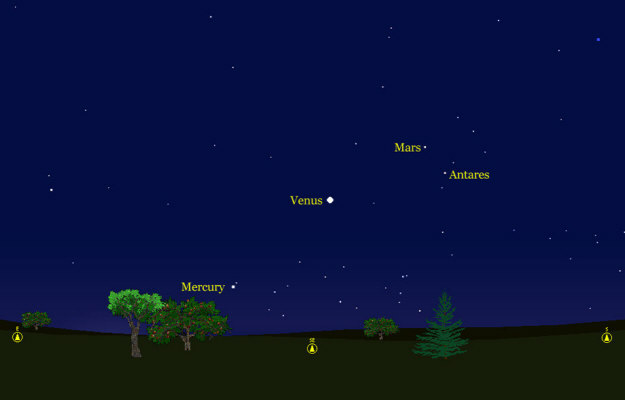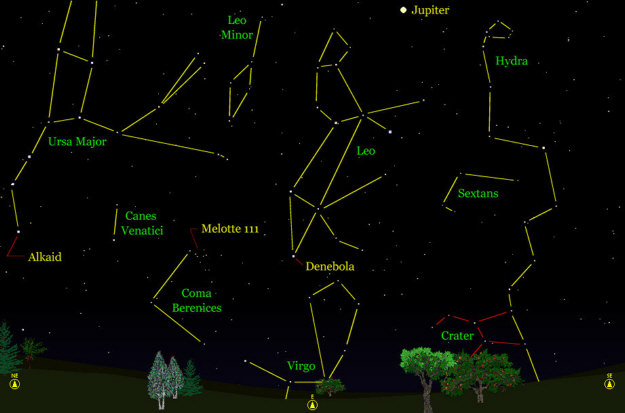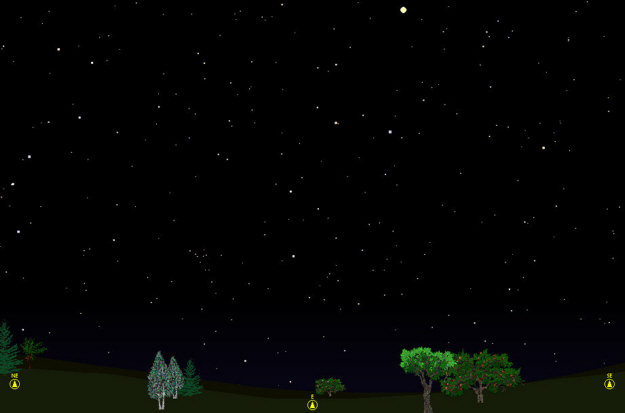The purpose of this feature is to give scout leaders, educators and naturalists an idea of some of the natural events coming up each month. We will try to cover a variety of natural events ranging from sky events to calling periods of amphibians, bird and mammal watching tips, prominent wildflowers and anything else that comes to mind. We will also note prominent constellations appearing over the eastern horizon at mid-evening each month for our area for those who would like to learn the constellations. If you have suggestions for other types of natural information you would like to see added to this calendar, let us know! Note: You can click on the hyperlinks to learn more about some of the featured items. To return to the Calendar, hit the "back" button on your browser, NOT the "back" button on the web page. Sky Events: Evening Sky: Jupiter and Saturn continue to shine brightly in the evening sky all month. Morning Sky: The planet Venus continues to be dazzling in the morning sky before sunrise in February, and forms a pretty grouping with Mercury and Mars in the first part of the month. Compare Mars to the red giant Antares, to the right of it and below. The name Antares means, "rival of Mars." You will want an unobstructed southeastern horizon to see Mercury well.
All times noted in the Sky Events are for Franklin, Tennessee and are Central Standard Time. These times should be pretty close anywhere in the mid-state area. Constellations: The views below show the sky looking east at 9:00pm CST on February 14th. The first view shows the sky with the constellation outlines and names depicted. Star and planet names are in yellow. Constellation names are in green. The second view shows the same scene without labels. The planet Jupiter dominates the sky, and is brighter than any other star-like object in the evening sky. See if you can pick out any of its four bright moons with binoculars. You need to steady your arms against something when you do this. Below and to the left of Jupiter is the constellation Leo, the Lion. The head of Hydra is to the right of Jupiter and the Water Serpent extends down to the horizon and below. See if you can make out the faint stars of Sextans, the Sextant. Going back to Leo, find Denebola, the star that marks the tip of the tail of the lion. Visualize a line from Denebola to Alkaid, the star that marks the end of the handle of the "Big Dipper." About 1/3 of the distance from Alkaid to Denebola is the constellation of Canes Venatici, the Hunting Dogs. About 2/3 of the distance from Alkaid to Denebola is the open cluster Melotte 111, in Coma Berenices (Berenice's Hair). It's a pretty grouping of stars in binoculars.
On Learning the Constellations: We advise learning a few constellations each month, and then following them through the seasons. Once you associate a particular constellation coming over the eastern horizon at a certain time of year, you may start thinking about it like an old friend, looking forward to its arrival each season. The stars in the evening scene above, for instance, will always be in the same place relative to the horizon at the same time and date each January. Of course, the planets do move slowly through the constellations, but with practice you will learn to identify them from their appearance. In particular, learn the brightest stars (Like Alkaid and Denebola in the above scene looking east), for they will guide you to the fainter stars. Once you can locate the more prominent constellations, you can "branch out" to other constellations around them. It may take you a little while to get a sense of scale, to translate what you see on the computer screen or what you see on the page of a book to what you see in the sky. Look for patterns, like the stars of the "Big Dipper." The earth's rotation causes the constellations to appear to move across the sky just as the sun and the moon appear to do. If you go outside earlier than the time shown on the charts, the constellations will be lower to the eastern horizon. If you observe later, they will have climbed higher. As each season progresses, the earth's motion around the sun causes the constellations to appear a little farther towards the west each night for any given time of night. If you want to see where the constellations in the above figures will be on March 15th at 9:00pm CST, you can stay up till 11:00pm CST on the February 15th and get a preview. The westward motion of the constellations is equivalent to two hours per month. For instance, if you want to see what stars will be on your eastern horizon on May 15th at 9:00pm CST (3 months later), you would need to get up at 3:00am CST in the morning on February 15th (3 months times 2 hours/month = 6 hours). A good book to learn the constellations is H. A. Rey's classic, The Stars, A New Way to See Them. Rey's depictions of the constellations and witty style commentary are terrific. A good general reference book on astronomy is the Peterson Field Guide, A Field Guide to the Stars and Planets, by Pasachoff. The book retails for around $14.00. A good beginners software program for learning the night sky is the Starry Night Beginner program. Visit the Starry Night web site at www.starrynight.com The program retails for around $30.00 and contains a wealth of information. Circumzenithal Arcs: Fall, Winter and Spring are good times to watch for these beautiful arcs that form directly overhead. Be sure to look upward in the late afternoon anytime you have wispy cirrus clouds in sky.
Amphibians: The amphibian season continues to build in February. Although the very cold weather that we've had in January has slowed things down a little bit this winter, be on the lookout when the weather warms up, even briefly. The trick is to go out on mild (50 degrees Fahrenheit or warmer) rainy nights. For safety, it is important that you have another person with you to watch for traffic as you slowly drive the back roads, looking for things that cross the road in front of you and frequently stopping and listening. Early breeding frogs, like Upland Chorus Frogs, Spring Peepers, and Wood Frogs can be calling already by the first of the month. Spotted Salamanders and Tiger Salamanders also breed in January and February and the eggs of both can often be found this time of year. Southern Leopard Frogs are also sometimes calling on mild February nights. Towards the end of the month, given mild temperatures, you can sometimes hear American Toads beginning to call, and in west Tennessee, Northern Crawfish Frogs give their loud snoring calls. At higher elevations, listen for Mountain Chorus Frogs towards the end of the month. Remember that on mild nights you may find frogs and toads out foraging that you do not hear until later in the season. Birds: Many times when we have been out looking for amphibians in February we've witnessed courtship flights of the American Woodcock. Listen for the "peent" call at dusk and watch as the male Woodcock spirals upward till it's almost out of sight, then dives back to the ground, twisting and turning. On February 2nd, we witnessed two Red-Shouldered Hawks mating in a wetland near Springfield, Tennessee. Be on the lookout for courtship displays of these hawks. You probably have already put out your bird feeders, but if you havenít you're missing out on a lot of good looks at winter feeder birds. This is a great time of year to start learning your birds. Watch and listen for winter residents such as White-throated and White-crowned Sparrows, Yellow-bellied Sapsuckers, Red-breasted Nuthatches, Golden-crowned Kinglets and Brown Creepers. Recommended: The Sibley Guide to Birds, David Allen Sibley For the eastern United States only, A Field Guide to the Birds East of the Rockies, Roger Tory Peterson An inexpensive guide for beginners is the Golden Guide for Birds.
Wildflowers: One of the nice things about taking hikes in February is looking for early spring wildflowers like Spring Beauties, Harbinger-of-Spring and Cut-Leaf Toothwort. Archives (Remember to use the back button on your browser, NOT the back button on the web page!) Natural Calendar December 2002 Natural Calendar November 2002 Nature Notes Archives: Nature Notes was a page we published in 2001 and 2002 containing our observations about everything from the northern lights display of November 2001 to frog and salamander egg masses. Night scenes prepared with Starry Night Pro software
|


